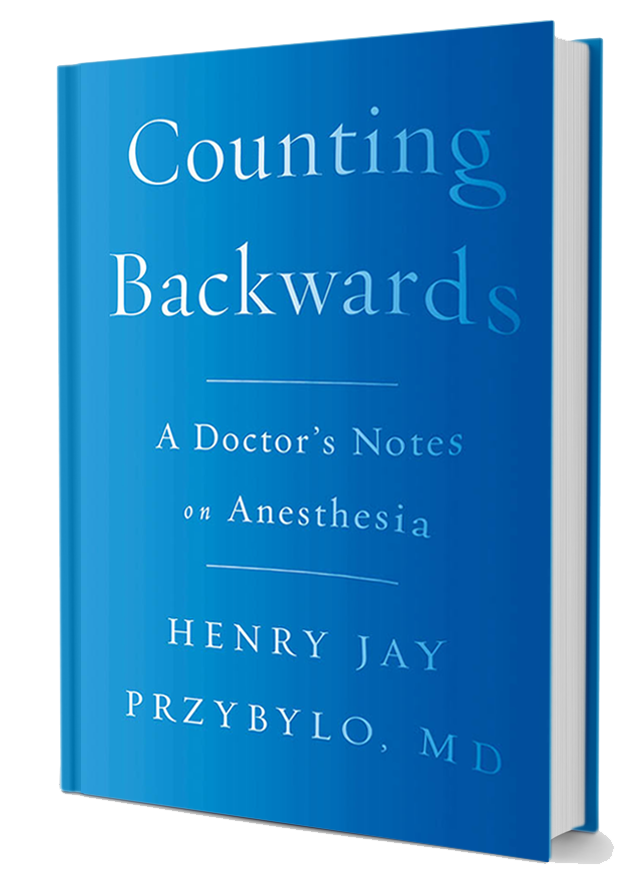I am an anesthesiologist, I erase consciousness, deny memories, steal time, immobilize the body; I alter heart rate, blood pressure, and breathing. And then I reverse these effects. I eliminate pain during a procedure, and prevent it afterwards. I care for sick people and I have saved lives, but it’s rare that I’m the actual healer. As an anesthesiologist, I do nearly all of my hands-on work behind automatic double doors, sequestered, allowing surgeons to cut, gastroenterologists to probe, cardiologists to stick. The patients I care for place their faith in me, but we’ve usually been introduced only a few minutes before, and they rarely remember my name after their surgery or procedure is completed.
I put people into a coma, and the medications I administer cause paralysis. Yet only a handful of times each year do patients or family members ask how anesthesia actually works. The truth is there is much about anesthesia that even modern science can’t yet explain.
But I know, as sure as the sun rises in the morning, that when I add a gas to the inhaled breaths, loss of consciousness follows; and when I remove the gas, awareness returns. This is a harrowing responsibility, and one I never take for granted.
Forty million people in the United States undergo anesthesia every year. It is the most frequently performed medical procedure that entails risk to the patient. The anesthesiologist is ubiquitous but largely invisible. Before the slash of the scalpel, the insensibility to pain is taken for granted. More people, up to a hundred million per year, seek relief from pain, both acute and chronic. Pain is the most common human health issue.
As an anesthesiologist of more than thirty years’ experience, working in a come-one-come-all practice within a large university health care system, I have administered anesthesia more than thirty thousand times during my career. To newborn babies, to kids, to adults in the prime of life, to centenarians. To patients dealing with the most benign conditions (removing a skin mole or placing infection-clearing tubes in eardrums) and to those facing potentially fatal ones (clipping a cerebral artery aneurysm). I specialize in pediatric anesthesiology, caring for about a thousand children in an average year—from one-and-a-half-pound micro-preemies with skin so new that the tissues and bones beneath are clearly visible, to massively obese teenagers.
Anesthesiologists don’t keep regular hours; our care and expertise are called upon at all times, from midday elective colonoscopies to middle-of-the-night emergency trauma. There’s always an on-call anesthesiologist ready to respond. Day in, day out, most of the waking hours of my life are spent in that cloistered place behind the automatic double doors.
Anesthesiology allows little of what was learned in medical school to be forgotten. Perhaps no other specialty remains as expansive or inclusive, covering all the basic sciences (anatomy, pathology, physiology, pharmacology) and all fields of clinical medicine (internal medicine, surgery, pediatrics, obstetrics, and even psychiatry), and interacting with every other conceivable specialty. On any given day, any page of the physiology, pathology, or pharmacy texts may need to be scoured for a reference. From the time we meet in the pre-anesthesia area until the point that, after the procedure is over, I’m assured my patient has returned to a state of comfort and is prepared to reunite with loved ones, I am the primary care physician. During my anesthesia care, I become the internist, the ob-gyn, the pediatrician. The child scheduled to have a skin mole removed might have a failing heart; the woman whose brain aneurysm has burst might also suffer the pain and deformities of rheumatoid arthritis. When things take a turn for the worse during a procedure, when the blood loss climbs or the heart rhythm goes awry, it’s left to the anesthesiologist to make life right.
Over 170 years ago, inhaling a gas was shown to render a person senseless and thereby allow invasive medical procedures. Health care exploded. The magnitude of this medical discovery remains obvious today. The number of patients receiving anesthesia grows every year. The renowned New England Journal of Medicine recently polled its readers to select the most important article the magazine had published in its distinguished history. The “resounding favorite” its readers settled on was the NEJM’s 1846 article by Henry Jacob Bigelow about the demonstration showing that inhaling ether allows for pain-free surgery. (“Anesthesia” as a term had not yet been coined.) This article, published just a few months after the historic demonstration at Mass General’s Ether Dome in Boston, bested every advance made since then, including the introduction of antisepsis, of X-ray imaging, and of antibiotics.
More than a century and a half later, I am unable to provide an answer when patients and families ask the most basic question of my specialty: how the gas I use anesthetizes. Despite decades of research, its mechanism of action remains a mystery. I must have faith in my anesthesia gas. It’s an irony of our work that patients and their loved ones place faith in the anesthesiologist, who in turn places faith in the gas. In many ways, I’m a faith healer.
I routinely ask patients to count backwards as the anesthesia medications are introduced. Counting backwards in this way is a time-honored anesthesiology tradition. When rapid-acting barbiturates were introduced half a century ago, making it possible to induce loss of consciousness in a matter of seconds, an anesthesiologist likely asked a patient to start at 100 and count back, curious to determine the speed of induction.
100 . . . 99 . . . 98 . . .
The practice stuck.
In my experience, patients never make it out of the 90s.

